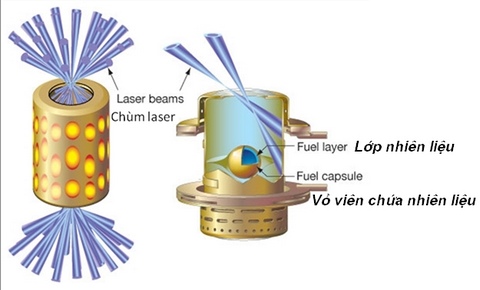In 2030, the fusion power plant was born
In 2030, the fusion power plant will come into being. These 12 power plants will provide 1 trillion watts of electricity (about 1,000 times the capacity of Hoa Binh hydropower plant) by 2100.
In March 2010, in a report in Science Express, scientists at Lawrence Livermore National Institute reported positive results on the operation of the national activation system - NIF (National Ignition). Facility) for fusion reactions.
The scientists measured a temperature of about 3 million degrees K in the reaction chamber. Electromagnetic waves from the laser beam will bring the fuel chamber pressure to about 100 billion times the earth pressure. This tremendous pressure will raise the temperature of the heavy hydrogen fuel to about 100 million degrees K, enabling the fusion reaction to be easy.
According to calculations, the energy emitted when burning 1mg of hydrogen fuel is equivalent to the radiant energy of a barrel of kerosene. Heavy hydrogen is abundant in seawater, so this is an endless fuel source.

192 laser beams converge at the fuel chamber to facilitate the fusion reaction.When all these lasers are converged, it will provide about 2 million joules of ultraviolet energy at the point of convergence in the reaction chamber.This energy will create a special environment that activates the fusion reaction (Photo: Lawrence Livermore National Laboratory)
Forhalf a century, scientists have studied to be able to control fusion reactions in laboratory conditions.The fusion reaction is the fusion of a light atomic nucleus into a heavier atomic nucleus while emitting a lot of energy.The fusion reaction is well known in the core of stars like our sun.
NIF began operations in 2010, the dream of 'creating a small sun' on earth by scientists and humanity in the past half century will become a reality in the near future.
The thermonuclear reaction activation system consists of 192 giant laser pulse generators, built at a cost of $ 3.5 billion.NIF will provide at least 60 times the energy of the largest laser system ever.
When all these lasers are converged (see illustration) , it will provide about 2 million joules of ultraviolet energy at the point of convergence in the reaction chamber.This energy will create a special environment that activates the fusion reaction.
This is an environment that exists only in the core of stars, massive planets and in nuclear weapons explosions (reaction of super-heavy nuclear decay into lighter nuclei, while emitting huge amounts of heat but less than fusion reaction.
When a fusion reaction occurs, it releases a huge amount of energy, much larger than the energy needed to activate the reaction.

LIFE (Laser Inertial Fusion Engine) of a laser-activated fusion engine.Photo: Lawrence Livermore National Laboratory
In the future, based on the physical knowledge and technology applied to NIF, scientists will create laser-activated fusion motors - LIFE (Laser Inertial Fusion Engine).LIFE has a very positive prospect in solving global energy problems.
This is safe, endless energy and does not emit harmful emissions to the environment such as CO2.One of LIFE's other outstanding features is the creation of a lot of neutrons.Neutrons are then used to activate nuclear reactions in nuclear waste from nuclear power plants.A large amount of energy will radiate in this reaction.
Current nuclear power plants only burn 10% of uranium fuel rods.This waste material will be used in LIFE and will be burned to over 99%.LIFE will really contribute greatly to reducing the amount of dangerous nuclear radioactive waste for the earth.

Operating at the Lawrence Livermore National Research Institute (Photo: Lawrence Livermore National Laboratory)
The trial of activating NIF using fusion reaction will be conducted in 2010 - 2011. A first LIFE power plant will be tested in 2020. Finally, a complete commercial power plant will be commercialization in 2030.
If 12 LIFE-type power plants are built continuously from 2030 with a 5-year speed / plant, LIFE will provide 1 trillion watts of electricity (about 1,000 times the capacity of Hoa Binh hydropower plant) by 2100 This electricity output will supply 30% of US electricity demand at that time.
The experiments obtained from NIF will contribute greatly to energy security in the United States and around the world due to the abundant source of fusion energy. NIF is the result of cooperation between government, industry and research institutes across the United States.
Founded in 1952, Lawrence Livermore National Institute is responsible for the development of science and technology, providing a new solution to the most important problems of the United States and mankind.
- Grid fusion synthesis power in 2050
- The era of solar power
- The miniature sun provides endless energy for people
- He built the first new generation nuclear power plant
- May 27: Creating the highest temperature of 510 million degrees Celsius in the laboratory
- There are signs of nuclear decay at Japanese power plants
- Fusion thermos are dozens of times faster than spacecraft
- Japan built a new nuclear power plant in Aomori
- Russia is committed to building safe nuclear power for Vietnam
- It takes 40 years to close Japanese nuclear power plant
- Solar plant operates at night
- Fukushima nuclear plant lost power due to ... mouse
 'Barefoot engineer' invents a pipeless pump
'Barefoot engineer' invents a pipeless pump Process of handling dead pigs due to disease
Process of handling dead pigs due to disease Radiometer
Radiometer Warp Engine: Technology brings us closer to the speed of light
Warp Engine: Technology brings us closer to the speed of light